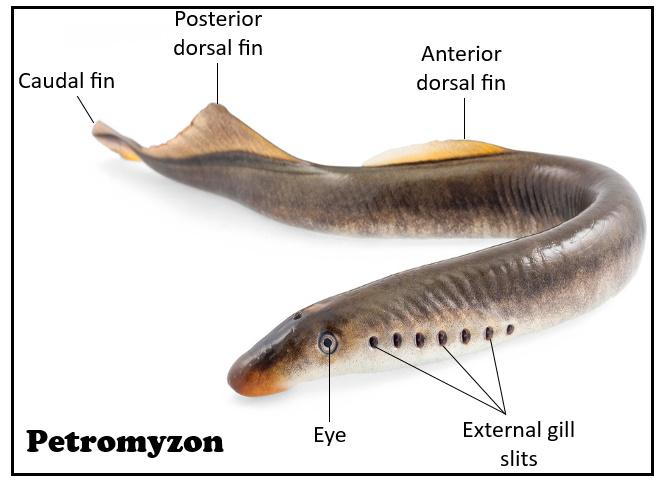
Lamprey (Petromyzon) is included in
(a) Gnathostomata
(b) Cyclostomata
(c) Chondrichthyes
(d) Osteichthyes
Answer
584.4k+ views
Hint: This is a group of animals where the animals lack jaws in their mouth and have some horny epidermal structures that serve the functions of teeth.
Complete answer: Lamprey can be any of the about 43 species of primitive fishlike jawless vertebrates that are placed with hagfishes in the Agnathans class of the superclass Cyclostomata. They will live on the coastal and fresh waters and are commonly found in the temperate regions, except Africa. The scaleless animals will range from 15 to 100 centimeters long. They possess well-developed eyes, have one to two dorsal fins, a single nostril on the head, a tail fin, and seven-gill openings on every side of the body. Similar to the hagfishes, they do not have bones, jaws, and paired fins. The skeleton of a lamprey has cartilage and the mouth is round with horny teeth.
Lampreys will begin its life as burrowing freshwater larvae. During this stage, they don’t have a tooth and will feed on the microorganisms. After many years, they will transform into adults and will move to the sea and begin a parasitic life, by attaching itself to a fish via their mouths and will feed on the blood and tissues of the host. However, not all lampreys will live in the sea. Some will remain in the freshwater.

So, the correct answer is ‘Cyclostomata’.
Note: During the reproduction process, lampreys will not eat and will conserve its energy for reproduction. For reproduction, they will return to the freshwater, build a nest, lay their eggs, and will eventually die.
Complete answer: Lamprey can be any of the about 43 species of primitive fishlike jawless vertebrates that are placed with hagfishes in the Agnathans class of the superclass Cyclostomata. They will live on the coastal and fresh waters and are commonly found in the temperate regions, except Africa. The scaleless animals will range from 15 to 100 centimeters long. They possess well-developed eyes, have one to two dorsal fins, a single nostril on the head, a tail fin, and seven-gill openings on every side of the body. Similar to the hagfishes, they do not have bones, jaws, and paired fins. The skeleton of a lamprey has cartilage and the mouth is round with horny teeth.
Lampreys will begin its life as burrowing freshwater larvae. During this stage, they don’t have a tooth and will feed on the microorganisms. After many years, they will transform into adults and will move to the sea and begin a parasitic life, by attaching itself to a fish via their mouths and will feed on the blood and tissues of the host. However, not all lampreys will live in the sea. Some will remain in the freshwater.

So, the correct answer is ‘Cyclostomata’.
Note: During the reproduction process, lampreys will not eat and will conserve its energy for reproduction. For reproduction, they will return to the freshwater, build a nest, lay their eggs, and will eventually die.
Recently Updated Pages
The number of solutions in x in 02pi for which sqrt class 12 maths CBSE

Write any two methods of preparation of phenol Give class 12 chemistry CBSE

Differentiate between action potential and resting class 12 biology CBSE

Two plane mirrors arranged at right angles to each class 12 physics CBSE

Which of the following molecules is are chiral A I class 12 chemistry CBSE

Name different types of neurons and give one function class 12 biology CBSE

Trending doubts
One Metric ton is equal to kg A 10000 B 1000 C 100 class 11 physics CBSE

Explain zero factorial class 11 maths CBSE

What is 1s 2s 2p 3s 3p class 11 chemistry CBSE

Discuss the various forms of bacteria class 11 biology CBSE

State the laws of reflection of light

Difference Between Prokaryotic Cells and Eukaryotic Cells




